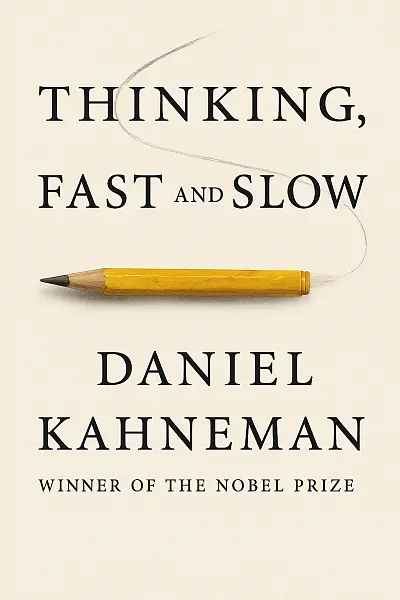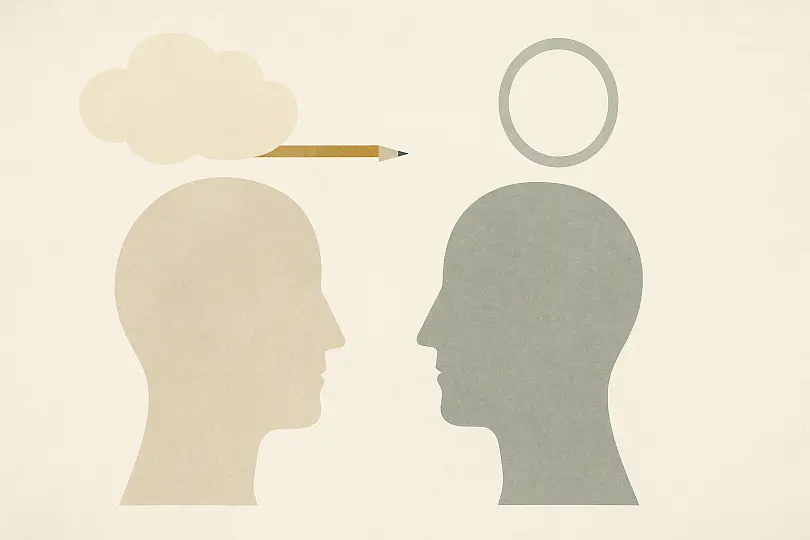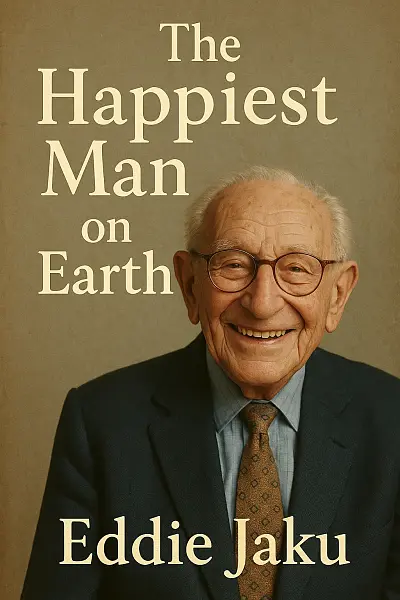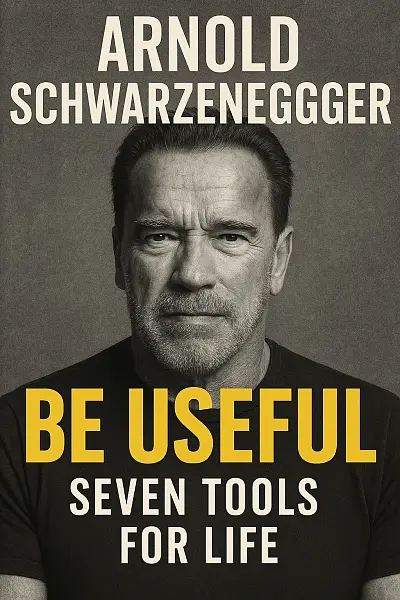
Thinking, Fast and Slow
by: Daniel Kahneman
Daniel Kahneman invites us into the maze of the human mind, where two systems—one quick and instinctive, the other slow and deliberate—swap the reins of our decisions in daily life. Everything feels familiar and manageable until Kahneman uncovers just how often our fast, intuitive thinking tricks us, throwing us off course with hidden biases and snap judgments.
Now, the stakes escalate: can we truly trust our gut when making major choices, or does our fast brain quietly sabotage us? As Kahneman pokes at our certainty and overconfidence, the pressing conflict emerges—can we ever outsmart our own minds, or are we stuck in a loop of mistakes?
With lively anecdotes and smart humor, the book crafts an intimate, almost conspiratorial atmosphere, nudging you to face the uncomfortable: will you start questioning your own thoughts, or keep coasting on auto-pilot?
"“The ease of intuition deceives us; wisdom begins when we pause to question what feels obvious.”"
Literary Analysis
Writing Style
Atmosphere
Clear-headed, intellectual, and surprisingly accessible—Kahneman crafts an environment that invites you into the world of cognitive science without ever feeling stuffy or intimidating. The tone is conversational yet authoritative, striking a balance between scholarly insight and friendly guidance. Expect a mood that's curious and gently provocative, consistently encouraging you to question your own thinking habits.
Prose Style
Clean, precise, and free of unnecessary jargon—Kahneman’s writing is impressively approachable given the complexity of the subject matter. He favors direct explanations, often speaking to the reader in straightforward terms, punctuated by relatable anecdotes, memorable experiments, and playful analogies. There’s an understated wit here and a knack for clarity: you'll never feel lost, even when the ideas get deep.
Pacing
Measured and methodical, but rarely sluggish. Kahneman takes his time building concepts layer by layer, ensuring that readers can follow each step without feeling overwhelmed. Chapters unfold with a steady rhythm—expect deep dives rather than rapid-fire revelations. Still, well-placed stories and punchy studies break up the density, so even the most intricate arguments stay lively and digestible.
Mood & Feel
Think of it as coffee with a wise friend who’s got stories, puzzles, and experiments up his sleeve. There’s a consistent undercurrent of curiosity—Kahneman genuinely wants you to see how human minds tick, nudging you toward self-discovery. It’s insightful without being dry, quietly revolutionary but never overstated.
Reader Experience
You’ll feel guided but not lectured, challenged but not lost. The layout makes this a book you’ll want to annotate, ponder, and discuss. It might read a bit slowly if you’re craving thriller-level momentum, but the intellectual rewards are well worth savoring. If you enjoy thinking about thinking, you’ll feel right at home.
Key Takeaways
-
Two minds at war: System 1’s snap judgments collide with System 2’s slow deliberation
-
Anchoring effect exposed: Watch your decisions shift, just from hearing a random number
-
Surprise! We’re all overconfident in predictions—Kahneman’s illusions reveal our blind spots
-
Page-turning experiments: Vivid real-life studies make you question every choice you’ve made
-
Loss aversion rules the day: Why losing $5 hurts more than winning $5 ever thrills
-
Cognitive bias bingo: From the lazy autopilot to the absent-minded professor—we all play these roles
-
Wry humor and confessional tone: Kahneman’s self-deprecation lets you laugh at your own mental missteps

How your two minds shape every choice—and surprise your intuition
Reader Insights
Who Should Read This
Who’s Going To Love Thinking, Fast and Slow?
-
If you’re obsessed with how the mind works—like you love picking apart why people (including yourself) make the choices they do—this book is serious catnip. Psychology geeks, fans of Malcolm Gladwell, or anyone who’s cursed with always overanalyzing everyday decisions will find so much to chew on here.
-
Economics and business buffs—if you enjoy a good “why do people act so irrationally with money?” convo, this is right up your alley. Kahneman digs into why we make weird financial choices, so anyone into behavioral economics or even those who love a deep-dive business podcast will find it fascinating.
-
Love a big idea non-fiction book? If you swoon for anything that makes you say, “Woah, I never thought of it like that!” every few pages (think Freakonomics, Nudge, or Blink), grab this one. It’s perfect for curious minds who like unpacking new concepts.
But, This Book Isn’t For Everyone…
-
If you prefer your non-fiction short and snappy, you might struggle here. This is not a beach read—it’s long and can get a little technical. Some parts are downright dense, so if you want something light or super-fast-paced, you might wanna pass.
-
Not into psych and econ stuff? If details about human behavior patterns or analysis of decision-making bore you, you’ll probably end up skimming (or snoozing...).
-
And honestly, if you’re looking for step-by-step self-help tips, this book is more about understanding the why than giving you a “here’s what to do next” action plan.
So, in a nutshell: If you love exploring how our brains are wired (and don’t mind wading through some thick science), you’ll be quoting this book for years. But if you want a breezy or purely practical read, it’s totally fine to skip—it’s a commitment!
Story Overview
Ever wondered how your brain makes decisions—even when you think you’re being totally logical?
Thinking, Fast and Slow sweeps you into the fascinating world of human thought, where two distinct “systems” inside your mind constantly duke it out: one intuitive and speedy, the other deliberate and rational.
Prepare to be intrigued, surprised, and maybe even a little humbled, as Daniel Kahneman guides you through the hidden mechanics of choice, bias, and—yep—just why we’re all a bit less in control than we think!
Main Characters
-
System 1: The intuitive, fast-thinking "character" that leaps to conclusions and operates automatically with little effort—think of it as your brain's autopilot, brilliant at generating quick impressions but prone to bias.
-
System 2: The slow, deliberate thinker—always analytical and logical, but a bit sluggish and easily tired. This character steps in for complex reasoning and calculations, but often takes a back seat when System 1 jumps ahead.
-
Daniel Kahneman: Serving as both author and narrator, Kahneman guides readers through the landscape of cognitive biases and psychological discoveries, blending personal anecdotes with groundbreaking research.
-
Amos Tversky: Kahneman’s intellectual partner and a quietly pivotal figure—his collaborative spirit and razor-sharp insights underpin the book’s foundation on human irrationality and decision-making flaws.
If You Loved This Book
If you found yourself mesmerized by the clever insights in Malcolm Gladwell’s Blink, you’ll likely be drawn into Thinking, Fast and Slow, which digs even deeper into the mysterious ways our brains make snap decisions—think of it as an ultra-illuminating companion read that peels back the layers on those gut feelings Gladwell loves to explore. Fans of Charles Duhigg’s The Power of Habit will also feel right at home here; both books unravel the hidden mechanisms behind our everyday behaviors, but Kahneman’s approach is more analytical, unpacking the very structure of thought itself rather than just our routines.
On the screen, the series Westworld echoes Kahneman’s ideas in fascinating ways—its android characters struggle between programmed instinct and emerging rationality, mirroring the tug-of-war between System 1 and System 2 thinking that Kahneman so brilliantly dissects. Both the book and the show leave you questioning just how much of your choices are really your own, blending science and suspense in a way that’s hard to shake.
Expert Review
Ever wondered why your gut sometimes leads you astray—even when you’re convinced you’re thinking straight? Thinking, Fast and Slow dares readers to confront this unsettling question, laying bare the invisible mechanisms shaping every judgment, choice, and risk we take. Kahneman’s exploration of the two systems of thought is not just a theoretical exercise—it’s an invitation to witness, and possibly outwit, our own cognitive fallibility.
Kahneman’s writing—steady, lucid, and genial—feels like a fireside chat with a Nobel laureate who’s more interested in being understood than in dazzling you with jargon. He leverages anecdotes, crisp metaphors, and elegantly structured thought experiments to bridge dense psychological theory and daily experience. Chapters flow logically, often pausing to invite readers into illuminating mini-experiments—try this puzzle; check your own snap judgment. While the prose rarely sparkles with literary flair, the clarity is masterful; complex concepts like availability bias or loss aversion are handled with an accessibility that’s rare in scientific nonfiction. Occasionally, the narrative bogs down in terminology or digressions, and some sections can feel repetitive, especially for readers already familiar with behavioral economics. Yet, the overall tone is warm, self-deprecating, and, crucially, patient with the curious layperson.
At its heart, the book grapples with human error and humility. Kahneman’s central insight—that our split mental apparatus trips us up in predictable, universal ways—becomes a springboard to investigate the limits of rationality, the hazards of overconfidence, and the price of happiness as imagined versus lived. He digs into the cultural and personal implications of these misfires, revealing how they ripple through everything from financial markets to everyday relationships. His perspective is timely: in a world awash with decisions—large and small—he forces us to question the trustworthiness of expertise, the durability of intuition, and the seductive illusion of certainty. By laying out how framing effects and gut-level “fast thinking” shape our politics, media, and private lives, Kahneman insists on the value—and necessity—of skepticism, both toward others and ourselves. This self-interrogation is not dry theory; it’s a call to a more reasonable, compassionate kind of modern citizenship.
Thinking, Fast and Slow stands alongside classics like Malcolm Gladwell’s Blink and Dan Ariely’s Predictably Irrational, but with far greater ambition, exceeding both in scholarly rigor and scope of implication. Kahneman’s contributions to behavioral economics seep into every chapter, giving weight and authority often missing in more anecdotal popular science. Yet, unlike drier academic texts, he never loses sight of the reader’s need for practical relevance and narrative drive—making the abstract personal and actionable.
Weaknesses? The book’s density and cumulative detail can overwhelm, especially in the latter half, risking reader fatigue. It’s not the breeziest read; some sections feel like lectures whose tangents could have been trimmed. Strengths? Its intellectual honesty, gentle wit, and the sheer transformative power of its ideas are unrivaled. Final verdict: Kahneman’s book is essential reading for anyone curious about the mind’s hidden levers—a rare blend of science and humanity, both sobering and empowering.
Community Reviews
I can't get over the part where Kahneman explains how our brains make snap judgments that feel right but are so wrong. It made me rethink every decision I make. That section about substitution really stuck with me.
Why did I think this would be a breezy read? Kahneman’s ideas about System 1 and System 2 stuck in my head so much that I started overthinking every decision, even picking a breakfast cereal. Sleep? Gone. Thanks, brain.
i started reading this at midnight and suddenly it was 4 am and i was questioning every decision i've made. kahneman’s breakdown of “system 1” and “system 2” thinking kept echoing in my brain and honestly, i couldn’t sleep for days.
Honestly, after reading about System 1 and System 2, I couldn’t stop analyzing every tiny decision I made—like, should I have cereal or toast? It’s like my brain got hacked and now I can’t turn it off.
i THOUGHT I had my mind figured out, but then Kahneman dropped "System 1 and System 2" on me and my brain hasn't rested since. That split-second gut vs. slow logic drama? I started questioning every choice, even my breakfast.
Cultural Context & Discussion
Local Perspective
Oh wow, Thinking, Fast and Slow really sparks some deep reflection for readers in Japan!
-
Parallel moments? The book’s exploration of intuition vs. logic parallels Japan's historical postwar transformation, when the nation pivoted from instinct-driven recovery to meticulous, rational planning during its economic miracle. That blend of gut feeling and strategic thinking feels super familiar in Japanese society.
-
Cultural vibes: Kahneman’s focus on cognitive biases gently nudges Japan’s group harmony leanings—where wa (和) often encourages conformity—making readers question when collective intuition actually stifles innovation or leads to “groupthink.” At the same time, the respect for deliberate, process-oriented thinking totally aligns with local values seen in tea ceremony or craftsmanship traditions.
-
Hits differently: The book’s warning about overconfidence stands out in a culture that prizes humility and self-restraint; readers might find it reassuring, rather than shocking.
-
Literary echoes: Its blend of storytelling and science strikes a chord reminiscent of popular Japanese non-fiction—think Ken Mogi or Haruki Murakami’s essays—where introspection and practical wisdom seamlessly interweave.
Points of Discussion
- Thinking, Fast and Slow has faced criticism for overstating the real-world applicability of its psychological experiments, particularly as the "replication crisis" in psychology has called some studies' findings into question.
- Critics have also debated whether Kahneman's distinction between "System 1" and "System 2" thinking is truly revolutionary or simply a handy metaphor, with some arguing it oversimplifies the complexities of human cognition.







